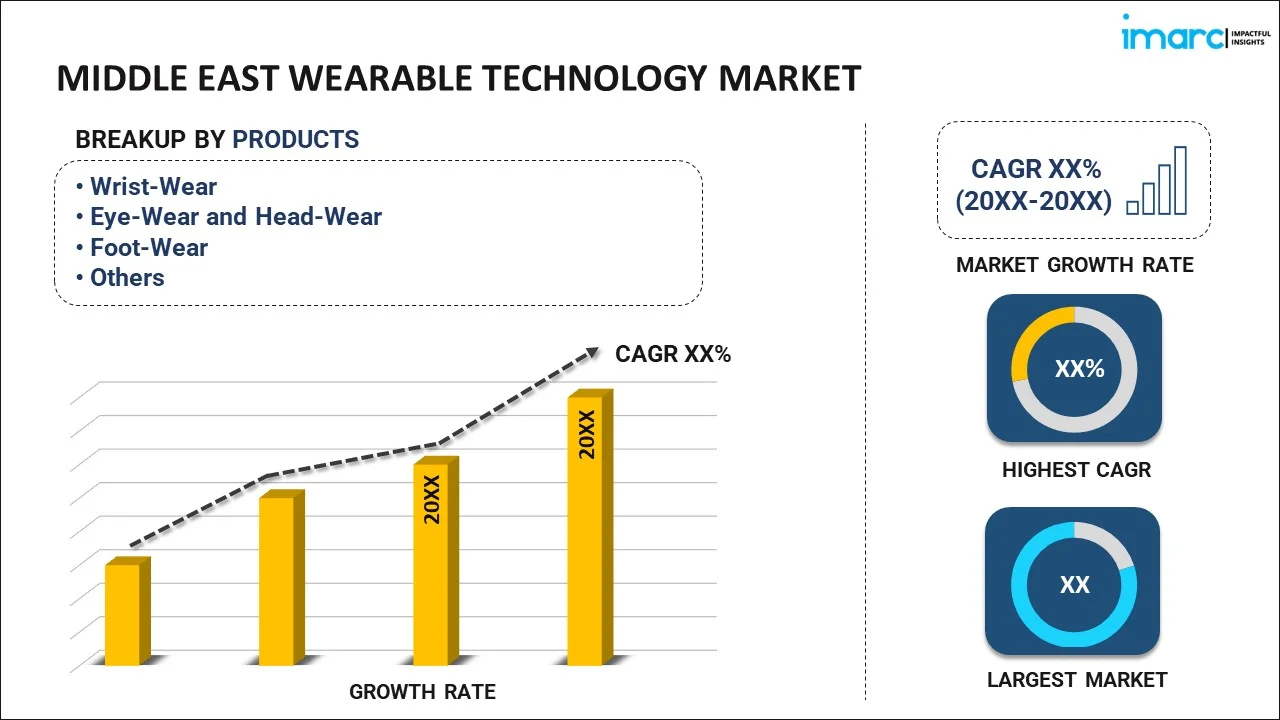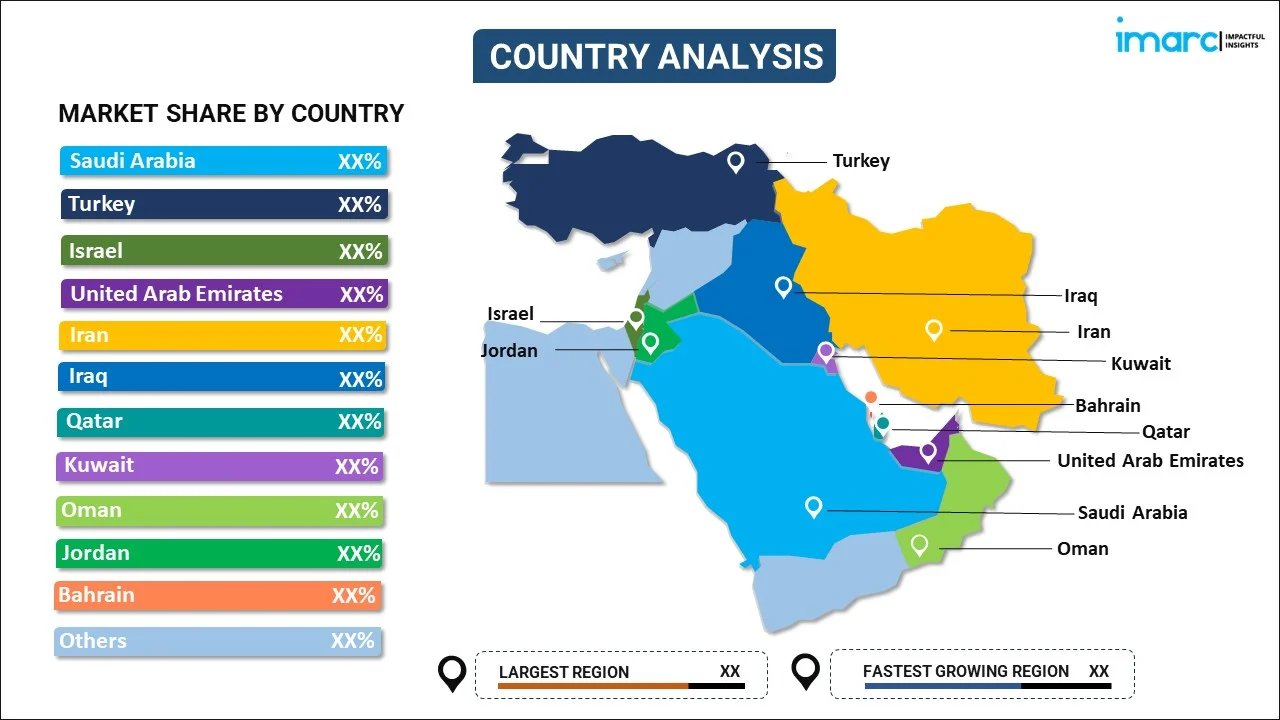
Middle East Wearable Technology Market Report by Product (Wrist-Wear, Eye-Wear and Head-Wear, Foot-Wear, Neck-Wear, Body-Wear, and Others), Application (Consumer Electronics, Healthcare, Enterprise and Industrial Application, and Others), and Country 2026-2034
Market Overview:
Middle East wearable technology market size reached USD 3,703.4 Million in 2025. Looking forward, IMARC Group expects the market to reach USD 12,718.1 Million by 2034, exhibiting a growth rate (CAGR) of 14.69% during 2026-2034. The growing demand for wearables that seamlessly integrate communication tools, rising demand for smartwatches, as they enable quick access to notifications, calls, and messages, and increasing convergence of technologies, such as internet of things (IoT), represent some of the key factors driving the market.
|
Report Attribute
|
Key Statistics
|
|---|---|
|
Base Year
|
2025
|
|
Forecast Years
|
2026-2034
|
|
Historical Years
|
2020-2025
|
|
Market Size in 2025
|
USD 3,703.4 Million |
|
Market Forecast in 2034
|
USD 12,718.1 Million |
| Market Growth Rate 2026-2034 | 14.69% |
Access the full market insights report Request Sample
Wearable technology can be worn on the body, often incorporating advanced sensors and connectivity features. It comprises smartwatches and fitness trackers, which are dedicated for monitoring physical activity, sleep, and health metrics, and provides personalized insights and encourages users to adopt a healthier lifestyle. It also consists of smart clothing, which integrates sensors directly into clothing, measuring various physiological parameters. It encompasses augmented reality (AR) devices like smart glasses and headsets, which overlay digital information onto the real world and enhance gaming, productivity, and navigation through immersive experiences. It is often integrated with a global positioning system (GPS), which can assist with navigation and location tracking. It is designed to seamlessly integrate into daily life, providing users with real-time data and enhancing their overall experience. It plays a crucial role in user acceptance and comfort, influencing the adoption of the device in different lifestyles. It streamlines daily tasks, reducing the need to constantly interact with other devices. It empowers individuals to take control of their well-being and facilitates early detection of potential issues, promoting proactive healthcare. It is used by various companies as part of employee wellness programs to promote a healthier lifestyle among their workforces. It collects a wide variety of data, which can be valuable for researchers and public health organizations.
Middle East Wearable Technology Market Trends:
At present, the increasing demand for smartwatches, as they enable quick access to notifications, calls, and messages, reducing the need for users to constantly check their smartphones, represents one of the crucial factors impelling the growth of the market in Middle East. Besides this, the miniaturization of components, enhanced sensor capabilities, and the integration of artificial intelligence (AI) are collectively driving the development of more sophisticated and feature-rich wearable devices. The convergence of technologies, such as internet of things (IoT) and advanced materials, is facilitating the production of wearables with greater functionality, improved battery life, and enhanced user experiences. In addition, individuals are actively seeking devices that go beyond basic activity tracking, providing comprehensive health insights and personalized recommendations. Smartwatches equipped with health monitoring features, including heart rate monitoring, sleep tracking, and stress management, are gaining popularity. Apart from this, the increasing integration of electrocardiogram (ECG) capabilities and blood oxygen monitoring in wearables is positioning them as valuable tools for preventive healthcare. Additionally, the rising demand for smartwatches and other wearables that seamlessly integrate with communication and productivity tools among individuals who are working remotely is supporting the market growth in the region. Moreover, AR glasses and smart helmets are gaining traction in industrial settings for various tasks, such as maintenance, training, and remote assistance. Manufacturers are increasingly focusing on design aesthetics, recognizing the importance of creating devices that not only offer cutting-edge functionality but also align with the style preferences of people.
Middle East Wearable Technology Market Segmentation:
IMARC Group provides an analysis of the key trends in each segment of the market, along with forecasts at the regional and country level for 2026-2034. Our report has categorized the market based on product and application.
Product Insights:

To get detailed segment analysis of this market Request Sample
- Wrist-Wear
- Eye-Wear and Head-Wear
- Foot-Wear
- Neck-Wear
- Body-Wear
- Others
The report has provided a detailed breakup and analysis of the market based on the product. This includes wrist-wear, eye-wear and head-wear, foot-wear, neck-wear, body-wear, and others.
Application Insights:
- Consumer Electronics
- Healthcare
- Enterprise and Industrial Application
- Others
A detailed breakup and analysis of the market based on the application have also been provided in the report. This includes consumer electronics, healthcare, enterprise and industrial application, and others.
Country Insights:

To get detailed regional analysis of this market Request Sample
- Saudi Arabia
- Turkey
- Israel
- United Arab Emirates
- Iran
- Iraq
- Qatar
- Kuwait
- Oman
- Jordan
- Bahrain
- Others
The report has also provided a comprehensive analysis of all the major regional markets, which include Saudi Arabia, Turkey, Israel, United Arab Emirates, Iran, Iraq, Qatar, Kuwait, Oman, Jordan, Bahrain, and Others.
Competitive Landscape:
The market research report has also provided a comprehensive analysis of the competitive landscape. Competitive analysis such as market structure, key player positioning, top winning strategies, competitive dashboard, and company evaluation quadrant has been covered in the report. Also, detailed profiles of all major companies have been provided.
Middle East Wearable Technology Market Report Coverage:
| Report Features | Details |
|---|---|
| Base Year of the Analysis | 2025 |
| Historical Period | 2020-2025 |
| Forecast Period | 2026-2034 |
| Units | Million USD |
| Scope of the Report | Exploration of Historical and Forecast Trends, Industry Catalysts and Challenges, Segment-Wise Historical and Predictive Market Assessment:
|
| Products Covered | Wrist-Wear, Eye-Wear and Head-Wear, Foot-Wear, Neck-Wear, Body-Wear, Others |
| Applications Covered | Consumer Electronics, Healthcare, Enterprise and Industrial Application, Others |
| Countries Covered | Saudi Arabia, Turkey, Israel, United Arab Emirates, Iran, Iraq, Qatar, Kuwait, Oman, Jordan, Bahrain, Others |
| Customization Scope | 10% Free Customization |
| Post-Sale Analyst Support | 10-12 Weeks |
| Delivery Format | PDF and Excel through Email (We can also provide the editable version of the report in PPT/Word format on special request) |
Key Questions Answered in This Report:
- How has the Middle East wearable technology market performed so far and how will it perform in the coming years?
- What has been the impact of COVID-19 on the Middle East wearable technology market?
- What is the breakup of the Middle East wearable technology market on the basis of product?
- What is the breakup of the Middle East wearable technology market on the basis of application?
- What are the various stages in the value chain of the Middle East wearable technology market?
- What are the key driving factors and challenges in the Middle East wearable technology?
- What is the structure of the Middle East wearable technology market and who are the key players?
- What is the degree of competition in the Middle East wearable technology market?
Key Benefits for Stakeholders:
- IMARC’s industry report offers a comprehensive quantitative analysis of various market segments, historical and current market trends, market forecasts, and dynamics of the Middle East wearable technology market from 2020-2034.
- The research report provides the latest information on the market drivers, challenges, and opportunities in the Middle East wearable technology market.
- Porter's five forces analysis assist stakeholders in assessing the impact of new entrants, competitive rivalry, supplier power, buyer power, and the threat of substitution. It helps stakeholders to analyze the level of competition within the Middle East wearable technology industry and its attractiveness.
- Competitive landscape allows stakeholders to understand their competitive environment and provides an insight into the current positions of key players in the market.
Need more help?
- Speak to our experienced analysts for insights on the current market scenarios.
- Include additional segments and countries to customize the report as per your requirement.
- Gain an unparalleled competitive advantage in your domain by understanding how to utilize the report and positively impacting your operations and revenue.
- For further assistance, please connect with our analysts.
 Request Customization
Request Customization
 Speak to an Analyst
Speak to an Analyst
 Request Brochure
Request Brochure
 Inquire Before Buying
Inquire Before Buying




.webp)




.webp)












